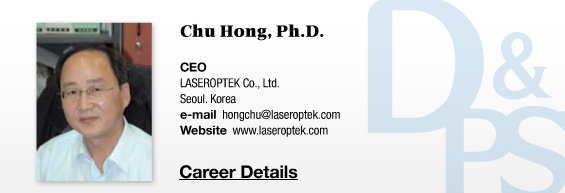In this new series, Mr. Chu Hong, CEO of LASEROPTEK, will discuss history of lasers used in aesthetic medicine focusing on important persons and background stories. He will introduce popular devices of each generation, letting us take a close look at how each laser device came into being and which lasers were used for a particular condition.
The history of medical laser goes back to the famous physicist Albert Einstein (1879-1955). In 1917, Einstein proposed the stimulated emission hypothesis based on Niels Bohr’s (Danish physicist, 1885~1962) theory that atoms absorb and release discontinuous energy ‘Quanta’ when they rise from the ground state to excited state or falls from the excited state to ground state. That is, when an atom in the excited state collides with a photon of the identical wavelength and direction, the atom releases a photon that has the same wavelength and direction as the colliding photon.
The theory of stimulated emission explains that two identical photons can be produced from the collision of a photon and an atom in the excited state. This signified that light could be amplified. The existence of Einstein’s stimulated emission was first confirmed in 1928 by a German physicist Rudolf Ladenberg. Collaborative research between physicists and electric engineers was conducted in the 1960s and a ruby laser was first developed by T.J. Maiman (1927~2007) based on the theory of stimulated emission. Currently, laser is so extensively used in many different fields that it would be difficult to imagine a world without laser.
Those who are interested in medical laser may wonder about what new developments the future holds. In this series, we will take a look at the history of medical laser, what types of laser devices were developed to satisfy the demands of the time and the types of new laser devices that may be needed in the future.
The birth and practical application of medical laser was pioneered by Dr. Leon Goldman (American dermatologist and surgeon; 1905~1997) from the 1960s to 1980s. The era of dermatologic lasers began in the 1980s and still continues. It was pioneered by Dr. R. Rox Anderson (American dermatologist) based on the theory of selective photothermolysis.
HELIOSⅡ/LOTUSⅡ/HYPERION – Manufacturer: LASEROPTEK(www.laseroptek.com)
If the very birth of laser owes to Einstein, medical lasers came into being thanks to Goldman. Goldman was a leader in laser surgery and medical laser. When he was serving as the chairman of the department of dermatology in 1961 at the University of Cincinnati, National Institute for Occupational Safety and Health asked him to conduct a study on the clinical safety of the world’s first laser, ruby laser. With the funding from John A Hartford Foundation, he was able to create a research team consisting of biologists, engineers and medical specialists for his Biomedical Laser Laboratory. He performed various studies on clinical applications of laser from 1961 to 1976. His first study examined using laser for treating melanoma in 1961. In 1966, he led the first bloodless laser tumor removal. This new method cut the skin and cauterized the blood vessels simultaneously and had profound influence on future laser surgery.
In 1963, Goldman published his seminal paper on the interaction between laser and skin as well as medical applications of laser in Science. Goldman published many studies on the potential of the Q-switched laser as a new treatment modality for pigmented lesions such as nevi, melanoma and tattoos. He also conducted clinical and histopathological studies on the effect of argon lasers on vascular lesions and vascular malformations. Moreover, he reported promising results of using CW (continuous wave) Nd:YAG laser in treating angioma.





















